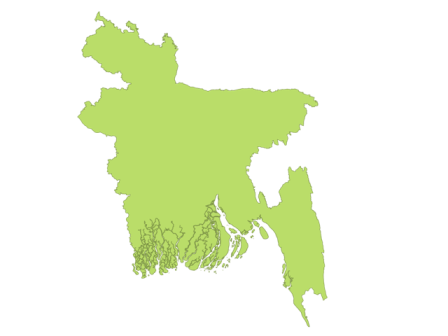South Asia -
Bangladesh
South Asia

Characterized by rising inequality and landlessness, Bangladesh has to be understood din the context of its political economy. Its economy is split between the powerful minority (comprising one million) and the ‘unempowered’ majority of 149 million. Land reform has progressed at a snail’s pace, while moral support and financial resources for it are lacking. Activists have encountered harassment from government and opposition from land grabbers and powerful people. Longstanding unresolved issues of land reform comprise: acquisition and distribution of khas land; limited land rights of ethnic and religious minorities; women’s access to land; and fishers’ access to water bodies. Other issues include land grabbing and commercial shrimp farming.
Monitoring in Bangladesh has adhered generally to the proposed indicators laid out in the CSO land reform monitoring framework. It has looked at policies and the budget; as well as land disputes, evictions, ownership and distribution of land, and landlessness, in the context of the government’s khas land distribution program.
The estimated total number of deaths attributed to land litigation is 32,073 in 2002. Considering the 2002-popultion size of Bangladesh, the ratio comes to 25.1 deaths per 100,000 populations.
Number of people detained:
The 2002 estimation showed that the total number of people detained due to land dispute/litigation would be 1.18 million. This means a ratio of 921 persons detained per 100,000 populations.
The estimated total number of people harassed due to land dispute/litigation was 26.3 million in 2002. The ratio was 2,071 persons harassed per 100,000 populations in 2002.
Number of cases received:
In 2009, the annual number of land-related new cases (law suits) was 63,158, implying 206 cases per 100,000 populations. In 2011, the absolute number of land-related new cases (law suits) has increased to 65,215, implying 210 cases per 100,000 populations (considering 2011 population).
Number of cases investigated:Extrapolation based on research findings shows a ratio of 51 cases investigated per 100,000 populations in 2002.
Number of cases adjudicated:Extrapolation for 2002 shows a ratio of 82 land-related cases adjudicated per 100,000 populations.
Land Grabbing Cases:Based on expert judgment by Abul Barkat, the annual number of land grabbing cases would be over 10,000 in 2011.
Percentage area of land grabbed:In 2010 report, it was shown that based on various relevant research works of Abul Barkat the estimated area of land grabbed was equivalent to 27% of all agricultural land and 16% of total land area in Bangladesh.
Average time (in years) for dispute resolution:Most reliable survey research shows that on average, it takes 9.5 years to resolve a land dispute with 11.4 years for civil suits, 7.9 years for criminal suits, and 7.5 years for revenue suits.
Monetary loss:The estimated annual amount of monetary loss associated with land disputes/litigation is Tk. 248,599 million (US $ 3,824.6 million) in 2002. Adjusted for inflation, the amount of such loss in 2012 would be about Tk.12,42,995 million (US $ 6 billion).
Loss of assets:The estimated amount of annual loss of assets, attributable to land litigation, is Tk. 115,195 million (US $ 1772 million, in 2002).
Households evicted:The approximate number of households evicted/displaced is 250,000 annually, or over 200 households per 100,000 populations.
Households becoming totally homeless:Data on this indicator is not available. However, based on informed judgment (by Abul Barkat) it has been estimated that in 2008, over 5,000 households have become totally homeless due to eviction.
Poverty, Hunger, and Food Security
Nutritional Status
Asian NGO Coalition for Agrarian Reform and Rural Development (2012). Securing the Right to Land: An Overview on Access to Land in Asia 2nd ed. Quezon City: ANGOC.
Barkat A. (2014). Land Reform Monitoring Report 2013: Bangladesh. A Scoping Study prepared for ANGOC and ALRD for the Land Watch Asia Initiative.
Ibid
Household Income Expenditure Survey, Bangladesh Bureau of Statistics
Barkat A. (2014). Land Reform Monitoring Report 2013: Bangladesh. A Scoping Study prepared for ANGOC and ALRD for the Land Watch Asia Initiative.
source: Paper prepared in behalf of the Association for Land Reform and Development (ALRD) for the Asian Alliance Against Hunger and Malnutrition (AAHM),2014 by Professor Dr. Nazma Shaheen and Saiful Islam, submitted to ANGOC as part of the AAHM initiative.
